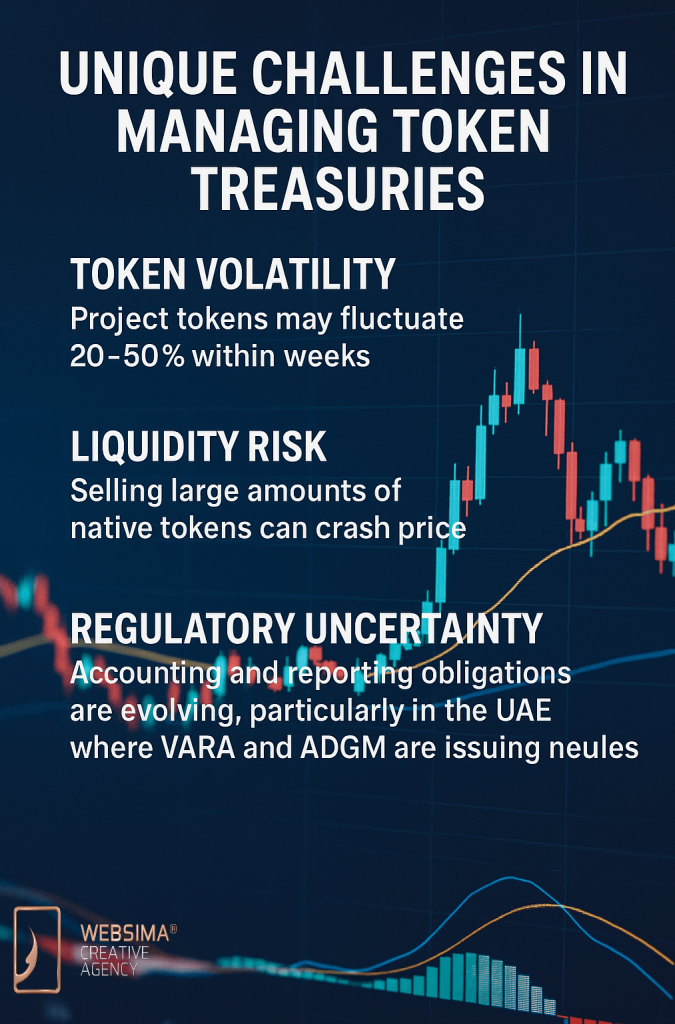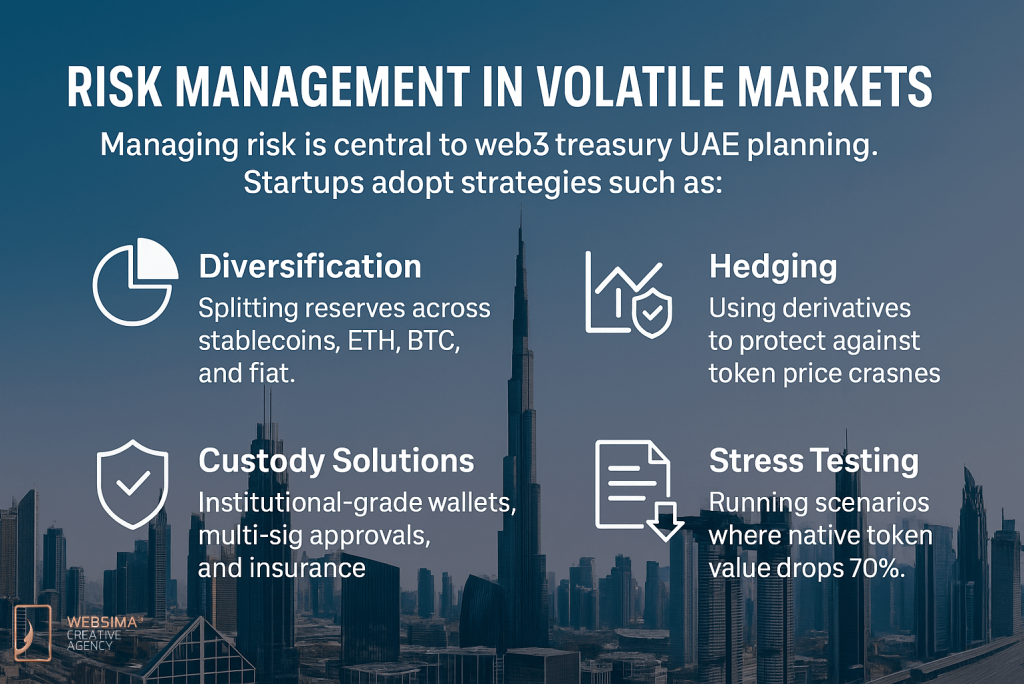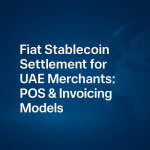Table of Contents
- Introduction
- Why Treasury Management Matters for Web3 Startups
- Unique Challenges in Managing Token Treasuries
- Stablecoins as the Core of Web3 Treasury UAE Strategies
- Yield Generation: From DeFi to Real-World Assets (RWAs)
- Risk Management in Volatile Markets
- Liquidity Safeguards for Operational Stability
- Case Study: A Hypothetical Dubai Web3 Startup
- Common Mistakes to Avoid
- Regulatory Landscape in the UAE
- Global Comparisons: How UAE Startups Differ
- Future Outlook: Institutionalization of Web3 Treasuries
- Frequently Asked Questions
- Conclusion
- Websima: Building the Future of Web3 Treasuries in Dubai
Introduction
The explosive rise of Web3 projects has created a new financial puzzle: how should startups manage large token treasuries? In 2025, token-funded startups and Web3 crowdfunding platforms in the UAE are facing the dual challenge of preserving liquidity for operations while generating returns on idle assets.
The market downturn of 2022–23 highlighted the risks of poor treasury planning. Projects that failed to diversify, hedge, or maintain stable liquidity buffers quickly found themselves unable to survive. Now, as Dubai and Abu Dhabi position themselves as global Web3 hubs, web3 treasury UAE strategies have matured into a discipline at the intersection of finance, risk management, and decentralized infrastructure.
UAE GOES FULL SEND ON WEB3
Dubai’s got VARA since 2018, and SCA doubled down in 2020—crypto vibes unmatched.
DIFC flexed with a 23% jump in fintech startups, no joke. 660 crypto-focused ones joined; MENA pulled $338.7B in on-chain value—UAE says, “Bet, we’re leading.”
Binance… pic.twitter.com/KGVilxa4ja
— 0xMarioNawfal (@RoundtableSpace) December 7, 2024
Why Treasury Management Matters for Web3 Startups
Unlike traditional startups funded with fiat, Web3 projects often raise capital in tokens. These tokens can be highly volatile, thinly traded, or subject to regulatory uncertainty. Treasury management is not just about storing funds — it’s about:
- Ensuring runway for salaries, development, and operations.
- Preserving value during market downturns.
- Generating low-risk yield to extend sustainability.
- Meeting investor expectations for governance and transparency.
Unique Challenges in Managing Token Treasuries

Web3 treasuries differ from traditional corporate treasuries in three major ways:
- Token Volatility – Project tokens may fluctuate 20–50% within weeks.
- Liquidity Risk – Selling large amounts of native tokens can crash price.
- Regulatory Uncertainty – Accounting and reporting obligations are evolving, particularly in the UAE where VARA and ADGM are issuing new rules.
These challenges force startups to think beyond “holding” and toward structured treasury frameworks.
Stablecoins as the Core of Web3 Treasury UAE Strategies
Stablecoins have emerged as the backbone of treasury diversification. USDT, USDC, and regionally compliant stablecoins and building smooth and friction-less fiat-crypto conversion for UAE users allow startups to denominate expenses in dollars while shielding themselves from volatility.
In the UAE, startups often:
- Convert a portion of native token reserves into stablecoins.
- Use multisig wallets for security.
- Allocate 12–18 months of stable operating expenses into low-risk stablecoin holdings.
UAE-based treasuries should also align their liquidity and custody strategies with Dubai’s Virtual Assets and Related Activities Regulations and official VARA Rulebooks, which establish licensing and compliance frameworks for virtual asset activities.
Yield Generation: From DeFi to Real-World Assets (RWAs)
Startups no longer rely exclusively on DeFi protocols for yield. In 2025, diversification includes:
- DeFi Lending Pools: Supplying stablecoins on platforms like Aave for 3–6% APY.
- Staking: ETH and Layer-2 staking for mid-yield with long-term upside.
- RWA Tokenization: Allocating part of treasury into tokenized T-bills or UAE real estate funds, offering 4–5% low-risk yields.
- CeFi (Centralized Finance) Custodians: Using regulated exchanges and custody providers for fixed-term yields.
This RWA exposure is particularly relevant in the UAE, where ADGM and DIFC actively support tokenized funds.
Risk Management in Volatile Markets

Managing risk is central to web3 treasury UAE planning. Startups adopt strategies such as:
- Diversification: Splitting reserves across stablecoins, ETH, BTC, and fiat.
- Hedging: Using derivatives to protect against token price crashes.
- Custody Solutions: Institutional-grade wallets, multi-sig approvals, and insurance.
- Stress Testing: Running scenarios where native token value drops 70%.
Security risk is real: over $2.17B was stolen from crypto services in H1 2025, according to Chainalysis’ Crypto Crime Mid-Year Update. This underscores the importance of professional custody and insurance safeguards.
Liquidity Safeguards for Operational Stability
Liquidity is the oxygen of a Web3 startup. Without accessible funds, even token-rich projects can collapse. Safeguards include:
- Runway Planning: Holding at least 18 months of fiat-equivalent liquidity.
- Segregation of Funds: Keeping operational expenses separate from speculative allocations.
- Custodian Partnerships: Working with UAE-regulated custodians for fiat conversion.
- Emergency Buffers: Reserving 10–15% in instant-access stable wallets.
Case Study: A Hypothetical Dubai Web3 Startup
Imagine a DeFi protocol based in DIFC that raised $20M in token sales:
- Allocation:
- 50% stablecoins for 18 months.
- 20% ETH staking.
- 15% in tokenized UAE T-bills.
- 10% native token liquidity support.
- 5% emergency buffer.
- Outcome:
- Stable runway insulated from market swings.
- Passive yield of 5% annualized from RWAs and staking.
- Transparency through quarterly reporting builds investor trust.
Common Mistakes to Avoid
- Overexposure to Native Token: Creates dependency and exit risk.
- Ignoring Fiat Needs: UAE operations still require AED/USD liquidity.
- Chasing Unsustainable Yields: Many 20%+ DeFi returns proved to be unsustainable.
- Weak Governance: Single-key treasury control leads to hacks and mismanagement.
Regulatory Landscape in the UAE
The UAE is positioning itself as a Web3 capital through structured regulation:
- VARA (Dubai): Regulates VASPs and token issuers via official Rulebooks.
- ADGM (Abu Dhabi): Its FSRA has published detailed Guidance on Virtual Asset Activities, covering authorization, technology, and financial crime compliance.
- DIFC (Dubai): Provides a common-law environment attractive to fintechs.
This clarity makes web3 treasury UAE strategies more robust than in jurisdictions with fragmented or unclear frameworks.
Global Comparisons: How UAE Startups Differ
- US: Heavy regulatory uncertainty, SEC enforcement actions.
- EU: MiCA provides clarity but imposes strict compliance burdens.
- Singapore: Strong compliance culture but narrower RWA scope.
- UAE: Balanced and transparent regulations, with access to tokenized RWAs and sovereign-backed initiatives.
Future Outlook: Institutionalization of Web3 Treasuries
- More RWAs: Tokenized bonds, sukuks, and real estate funds.
- Professional Treasury Roles: CFOs specializing in digital assets.
- Insurance Integration: On-chain insurance for treasury reserves.
- DAO Governance: Treasury allocations governed by token-holder votes.
Frequently Asked Questions
- Why is treasury management critical for Web3 startups?
Because startups often raise and hold volatile tokens, making liquidity planning essential for survival. - What role do stablecoins play?
They act as the base currency, reducing volatility and denominating expenses. - Can UAE startups invest in real-world assets?
Yes. ADGM-regulated funds already allow access to tokenized RWAs. - How do startups protect against hacks?
Multisig wallets, regulated custodians, and insurance policies. - What are the most common mistakes?
Overexposure to native tokens, poor fiat planning, and chasing unrealistic yields. - How does the UAE compare globally?
It offers regulatory balance and access to unique tokenized instruments.
Conclusion
The rise of web3 treasury UAE strategies reflects a maturing market. Token-rich startups can no longer afford to rely on speculative plays or unchecked volatility. Instead, successful teams are balancing yield, risk, and liquidity — while embracing the UAE’s regulatory clarity and global positioning.
Treasury management has evolved from a side consideration to a core strategic function. Startups that professionalize their treasury will be better positioned to survive downturns and capture long-term opportunities.
Websima: Building the Future of Web3 Treasuries in Dubai
At Websima, we specialize in guiding startups through the complexities of blockchain finance. From smart contract-based treasury automation to tokenized RWA integration, our solutions help Web3 projects build resilient financial systems.
Our services include:
- Treasury strategy design and automation.
- Tokenomics and liquidity planning.
- Smart contract development for yield management.
- UAE company establishment and compliance support.
If your startup wants to master treasury management in the UAE, contact Websima today. Together, we’ll build a treasury strategy that balances innovation with security.





